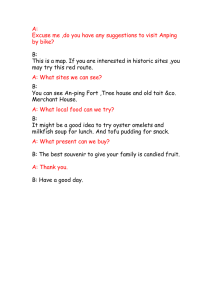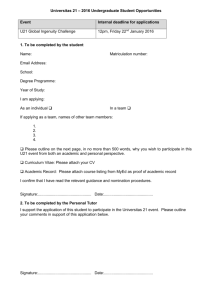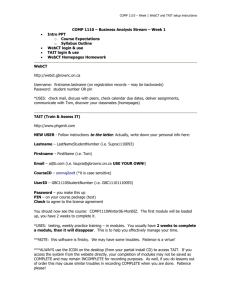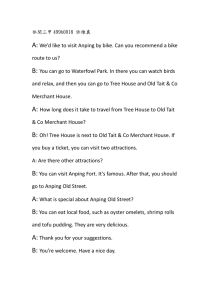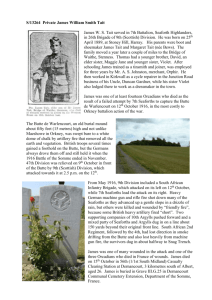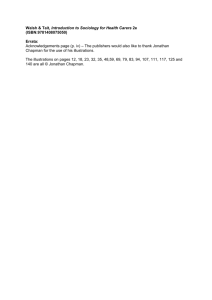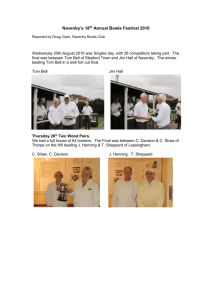Testing Criteria and Ingress Protection
advertisement
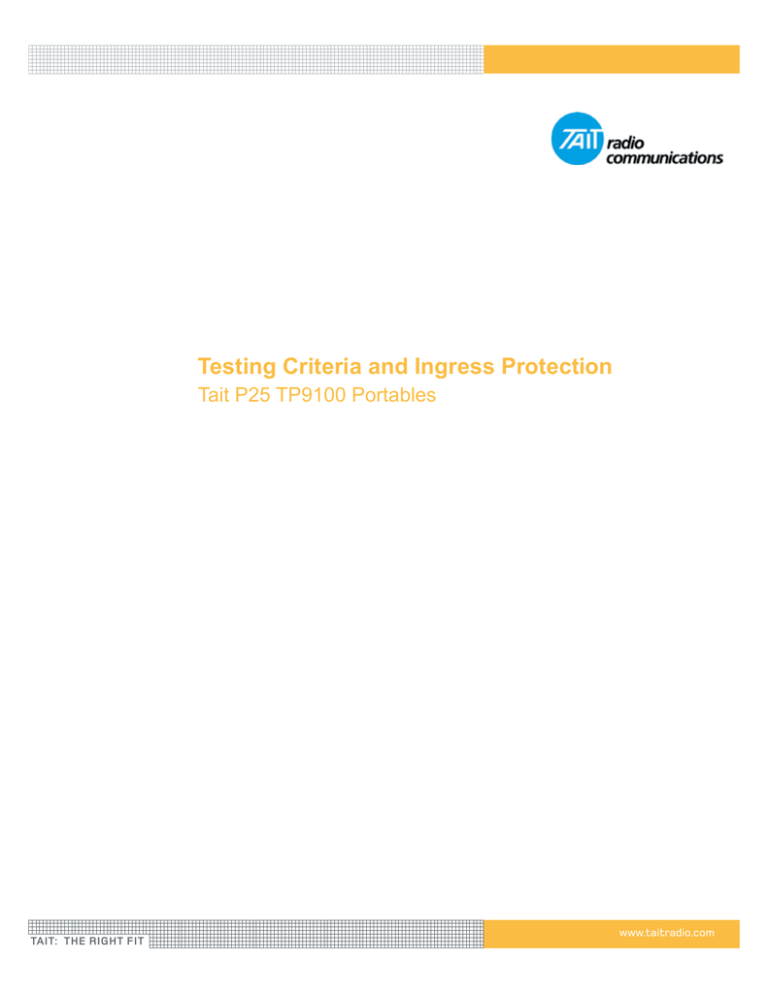
Testing Criteria and Ingress Protection Tait P25 TP9100 Portables TAIT: THE RIGHT FIT www.taitradio.com Contents Purpose..………………………………………......…............................... 03 Introduction.............................……………………….............................. 03 Ingress Protection Standards........……………………............................ 04 IP - Ingress Protection Ratings Military Standards..........……………………............................................ 06 Tait Standards..........……………………................................................. 06 Questions to Consider..........………………........................................... 07 Other Variables………...………………………….................................... 07 Conclusion.……………...………………………….................................. 07 Glossary.…………………………………………….................................. 07 Disclaimer Tait Electronics Limited marketed under the Tait Radio Communications brand. Tait Electronics Limited expressly disclaims all warranties, expressed or implied, including but not limited to implied warranties as to the accuracy of the contents of this document. In no event shall Tait Electronics Limited be liable for any injury, expenses, profits, loss or damage, direct, incidental, or consequential, or any other pecuniary loss arising out of the use of or reliance on the information described in this document. Copyright © 2010 Tait Electronics Limited. General terms of use for Tait technical documentation While Tait has taken every care to ensure that the information and contents are correct and up-to-date at the time of printing, the information may contain technical inaccuracies and/or printing errors. Tait does not guarantee the accuracy or correctness of the information. Tait cannot be held liable or responsible for errors or omissions in the contents of the technical documentation. All information contained in the technical documentation is given without warranties or representations, expressed or implied. Tait Radio Communications © Testing Criteria and Ingress Protection_Tait P25 TP9100 Portables_v1_Pg purpose The purpose of this document is to specify the testing criteria which the TP9100 radios had to exceed in the course of its development. It is intended for evaluators of radio solutions so that they can ask informed questions from their shortlisted manufacturers. The three main testing methodologies are: ■ Ingress Protection Standards ■ Military Standards ■ Tait Standards introduction The Professional Mobile Radio (PMR) manufacturers use Military Standards (MIL-STD) or IEC Ingress Protection (IP) Standards to ensure a consistent set of independently-established standards to allow users to compare based on these ratings. Like other manufacturers, Tait will test its products to these standards periodically as part of the design and engineering process. For example, engineering the 9100 series of radios so that it secured the IP54 rating required Tait to design a product that could be reliably sealed to prevent dust and water ingress. An independent laboratory tested and certified to the IP54 various criteria. Achieving such ratings and certification should not be confused with the general quality assurance checks that Tait undertakes as each radio is in production. Military standards such as MIL-STD-810 test against many other environmental criteria. The TP9100 meets MIL-STD-810C, D, E and F. It does NOT mean that the radios have been tested, used or approved by the armed forces! Certificates of compliance are often the minimum required, so Tait designs the radios to exceed many of these standards and invests in its own laboratory facilities to implement a rigorous testing regime. For example, Tait conducts their own environmental tests that include exceeding the MIL-STD-810F drop test and then using the same radio to carry out IP54 dust and rain tests. This also involves selecting and testing against the harshest parameters from previous MIL-STD-810F criteria, for example, Tait used the ‘C’ duration criteria for the rain test of 120 minutes (‘F’ is 15 minutes) while exposing it to the greater rainfall requirement of 810 ‘F’. Of course, the tests are intended to simulate “real life” conditions and care should still be taken to treat all radios appropriately! Tait Radio Communications © Testing Criteria and Ingress Protection_Tait P25 TP9100 Portables_v1_Pg Ingress Protection Standards IP - Ingress Protection Ratings An Ingress Protection rating is used to specify the environmental protection of electrical equipment. Ingress Protection (IP) ratings are developed by the European Committee for Electro Technical Standardisation (CENELEC) (described IEC/EN 60529) and specify the environmental protection an enclosure provides. The IP rating normally has two numbers: 1. Protection from solid objects or materials 2. Protection from liquids International Standard IEC 60529 outlines an international classification system that describes the sealing characteristics of electrical equipment. The classification system defines the level of protection provided by enclosures to prevent the ingress of foreign objects and moisture into the electrical equipment. The classification system uses the “IP” code, or “Ingress Protection” code, to define the level of seal. The IP code uses a system of two numerical digits to define the level of both foreign object and moisture protection. IP54 = IP 5 4 IP Letter Code 1st Digit 2nd Digit Left: IP numbering system Right: Testing the TP9100 to IPx4 - water splashed against the component from any direction The first digit of the IP code indicates the degree of protection against solid foreign objects from entering the electrical device. The second digit of the IP code indicates the degree of protection against the ingress of various forms of moisture (e.g. drip, spray, immersion, etc.) into the component. Tests to determine the level of protection are carried out with fresh water and do not take into account the use of solvents. * source is www.engineeringtoolbox.com Tait Radio Communications © Testing Criteria and Ingress Protection_Tait P25 TP9100 Portables_v1_Pg The following table explains the meaning of the different digits and shows the relevant international symbol. 1st Digit 0 1 Protection from solid objects Non protected Protected against solid objects greater than 50mm 2nd Digit 0 1 Protection from moisture Non protected Protected against vertically falling water drops 2 Protected against solid objects greater than 12.5mm 2 3 Protected against solid objects greater than 2.5mm 3 Protected against vertically falling water drops when enclosure is tilted up to 15° Protected against sprayed water 4 Protected against solid objects greater than 1.0mm 4 5 Protected from the amount of dust that would interfere with normal operation Dust proof 5 6 6 7 8 Protected against water splashed against the component from any direction Protected against water projected in jets from any direction Protected against water projected in powerful jets from any direction Protected against temporary immersion in water Protected against continuous immersion in water, or as specified by the user Please note: IEC 60529 does not specify sealing effectiveness against the following - mechanical damage of the equipment; the risk of explosions; certain types of moisture conditions, e.g.: those that are produced by condensation; corrosive vapours; fungus; vermin. Tait Radio Communications © Testing Criteria and Ingress Protection_Tait P25 TP9100 Portables_v1_Pg Military Standards Military Standard 810F sets out several different environmental specifications such as salt fog, high and low temperatures, vibration and humidity. Method 506.4 (Rain) comprises two procedures: Procedure I – Rain and Blowing Rain Simulates product being used in a driven rain environment: ■ 4in/hr rainfall rate for a duration of 150 minutes (100L/m2/hr) ■ Wind Velocity > 40mph (18 m/s) Procedure III – Drip Procedure III is appropriate when material is normally protected from rain but may be exposed to falling water from condensation or leakage from upper surfaces: ■ 11in/hr rainfall rate for a duration of 120 minutes (280L/m2/hr) Note that the schedule of criteria within revisions F supersedes revisions C, D and E. Tait will select the harshest parameters from current and former revisions, e.g.:Tait used the ‘C’ duration criteria for the dripping rain test of 120 minutes (‘F’ requires only 15 minutes) while exposing it to the greater rainfall requirement of 810 ‘F’. Another example of testing to the more demanding MIL-STD specification is low temperature which was specified as -57°C in schedule ‘C’, but was higher in subsequent revisions. When Tait tested to -57°C, this ensured it also passed/ exceeded the subsequent/less stringent revisions D, E and F. Tait Standards In addition to the testing reports issued by an independent external testing laboratory, Tait maintains its own testing facility. This facility conducts more extensive tests than the external test facility, often going beyond MIL-STD-810F. One such example is the MIL-STD-810F shock/transit drop test (516.5 procedure 4) where the standard requires manufacturers to drop their radio 26 times from 1.2 metres onto wood. Tait’s internal test criteria exceed the standard test by dropping the Tait radio 26 times from a height of 1.8 metres on to a concrete floor. After “distressing” a TP9100 radio in such a way, the same radio was then spray tested for 10 minutes on all surfaces to ensure it maintained its IP54 rating. Of course, while Tait specialises in making tough radios, no radio is indestructible. Care should still be taken to treat any radio appropriately. Tait Radio Communications © Testing Criteria and Ingress Protection_Tait P25 TP9100 Portables_v1_Pg QUESTIONS TO CONSIDER When evaluating a manufacturer’s testing regime, here are some questions to consider: ■ Does the manufacturer ‘cherry pick’ the criteria or test against the harshest possible from previous revisions? ■ When conducting the MIL-STD drop test, on to which surface does the manufacturer drop their radio? ■ Does the manufacturer conduct additional tests or procedures that go beyond the standard tests? ■ Does the manufacturer check the IP54 sealing on the same radio that has successfully undergone the drop tests? Or does it only test sealing on a radio that has not previously undergone any other tests? OTHER VARIABLES Independent testing criteria can be a useful indicator of a product’s quality of manufacture and general performance. However, it is only one indicator and many other factors can affect performance in the field. But many situational factors may affect the radio’s operation after such an incident including its age, operational use, the product’s usage history, weather and other environmental conditions. CONCLUSION As well as requesting certificates of compliance, evaluators of radio solutions are encouraged to ask some more probing questions that can help deliver valuable insights about a particular manufacturer’s testing regime. GLOSSARY Term Explanation PMR Professional Mobile Radio IP Ingress Protection Standards MIL-STD Military Standards CENELEC European Committee for Electro Technical Standardisation IEC International European Committee Tait Radio Communications © Testing Criteria and Ingress Protection_Tait P25 TP9100 Portables_v1_Pg
